Hyundai Terracan 2006 Owner's Manual
Manufacturer: HYUNDAI, Model Year: 2006, Model line: Terracan, Model: Hyundai Terracan 2006Pages: 539, PDF Size: 18.11 MB
Page 421 of 539
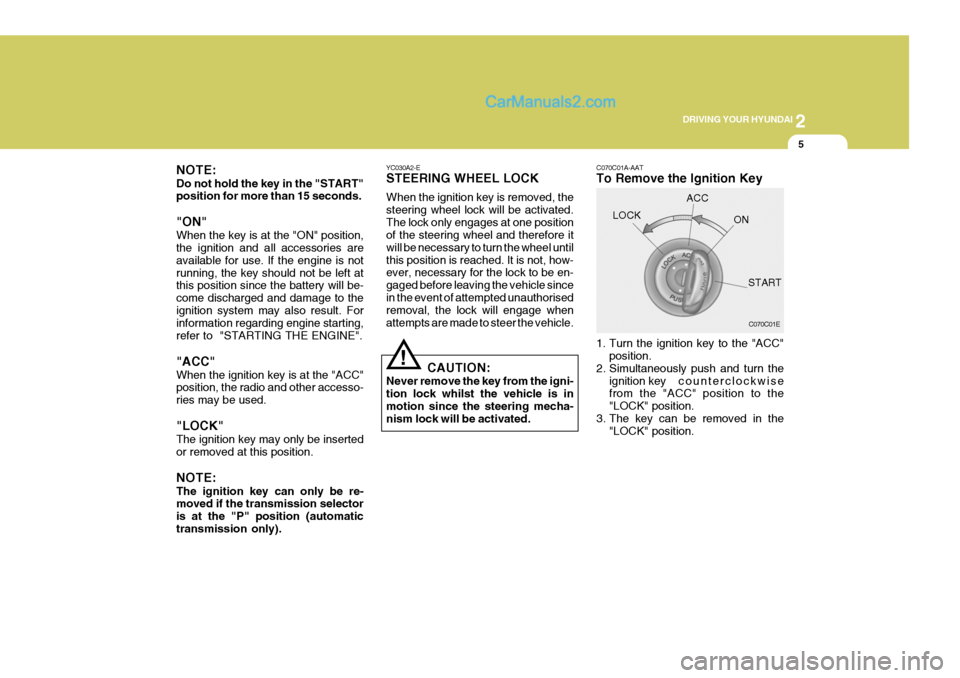
2
DRIVING YOUR HYUNDAI
5
!
YC030A2-E STEERING WHEEL LOCK When the ignition key is removed, the steering wheel lock will be activated.The lock only engages at one position of the steering wheel and therefore it will be necessary to turn the wheel untilthis position is reached. It is not, how- ever, necessary for the lock to be en- gaged before leaving the vehicle sincein the event of attempted unauthorised removal, the lock will engage when attempts are made to steer the vehicle.
CAUTION:
Never remove the key from the igni-tion lock whilst the vehicle is inmotion since the steering mecha- nism lock will be activated. C070C01A-AAT To Remove the Ignition Key
1. Turn the ignition key to the "ACC"
position.
2. Simultaneously push and turn the
ignition key counterclockwise
from the "ACC" position to the "LOCK" position.
3. The key can be removed in the "LOCK" position.
LOCK
C070C01E
ACC
ON
START
NOTE: Do not hold the key in the "START" position for more than 15 seconds. "ON" When the key is at the "ON" position, the ignition and all accessories are available for use. If the engine is notrunning, the key should not be left at this position since the battery will be- come discharged and damage to theignition system may also result. For information regarding engine starting, refer to "STARTING THE ENGINE". "ACC" When the ignition key is at the "ACC" position, the radio and other accesso- ries may be used. "LOCK" The ignition key may only be inserted or removed at this position. NOTE: The ignition key can only be re- moved if the transmission selector is at the "P" position (automatictransmission only).
Page 422 of 539
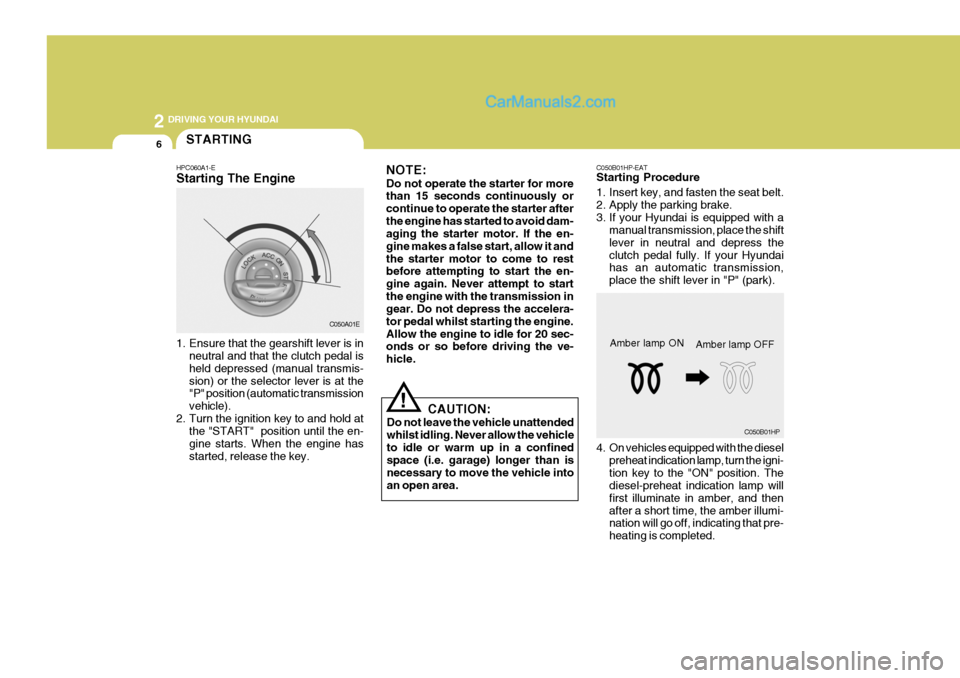
2 DRIVING YOUR HYUNDAI
6
!
NOTE: Do not operate the starter for more than 15 seconds continuously or continue to operate the starter afterthe engine has started to avoid dam- aging the starter motor. If the en- gine makes a false start, allow it andthe starter motor to come to rest before attempting to start the en- gine again. Never attempt to startthe engine with the transmission in gear. Do not depress the accelera- tor pedal whilst starting the engine.Allow the engine to idle for 20 sec- onds or so before driving the ve- hicle.
CAUTION:
Do not leave the vehicle unattendedwhilst idling. Never allow the vehicleto idle or warm up in a confined space (i.e. garage) longer than is necessary to move the vehicle intoan open area. C050B01HP-EAT Starting Procedure
1. Insert key, and fasten the seat belt.
2. Apply the parking brake.
3. If your Hyundai is equipped with a
manual transmission, place the shiftlever in neutral and depress theclutch pedal fully. If your Hyundai has an automatic transmission, place the shift lever in "P" (park).
Amber lamp ON
C050B01HP
Amber lamp OFF
4. On vehicles equipped with the diesel preheat indication lamp, turn the igni- tion key to the "ON" position. The diesel-preheat indication lamp will first illuminate in amber, and thenafter a short time, the amber illumi- nation will go off, indicating that pre- heating is completed.
1. Ensure that the gearshift lever is in
neutral and that the clutch pedal isheld depressed (manual transmis-sion) or the selector lever is at the "P" position (automatic transmission vehicle).
2. Turn the ignition key to and hold at the "START" position until the en-gine starts. When the engine hasstarted, release the key.
STARTING
HPC060A1-E Starting The Engine
C050A01E
Page 423 of 539
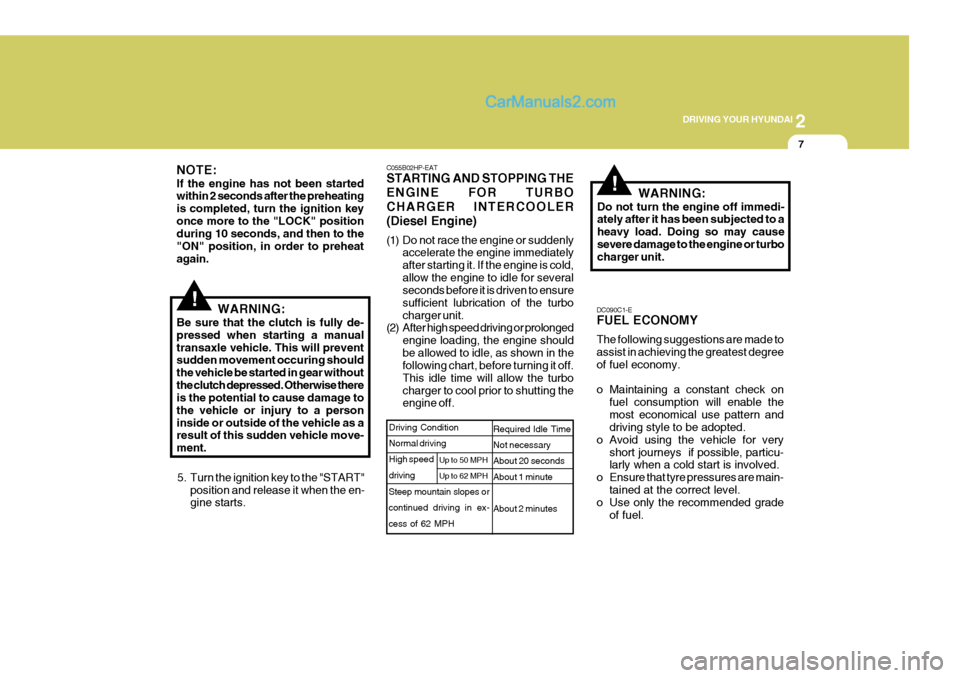
2
DRIVING YOUR HYUNDAI
7
!
NOTE: If the engine has not been started within 2 seconds after the preheating is completed, turn the ignition keyonce more to the "LOCK" position during 10 seconds, and then to the "ON" position, in order to preheatagain.
WARNING:
Be sure that the clutch is fully de-pressed when starting a manualtransaxle vehicle. This will prevent sudden movement occuring should the vehicle be started in gear withoutthe clutch depressed. Otherwise there is the potential to cause damage to the vehicle or injury to a personinside or outside of the vehicle as a result of this sudden vehicle move- ment.
5. Turn the ignition key to the "START" position and release it when the en- gine starts.
!
C055B02HP-EAT STARTING AND STOPPING THE ENGINE FOR TURBOCHARGER INTERCOOLER(Diesel Engine)
(1) Do not race the engine or suddenly accelerate the engine immediately after starting it. If the engine is cold,allow the engine to idle for several seconds before it is driven to ensure sufficient lubrication of the turbocharger unit.
(2) After high speed driving or prolonged
engine loading, the engine shouldbe allowed to idle, as shown in the following chart, before turning it off. This idle time will allow the turbocharger to cool prior to shutting the engine off. WARNING:
Do not turn the engine off immedi-ately after it has been subjected to a heavy load. Doing so may causesevere damage to the engine or turbo charger unit.
DC090C1-E FUEL ECONOMY The following suggestions are made to assist in achieving the greatest degree of fuel economy.
o Maintaining a constant check on fuel consumption will enable the most economical use pattern and driving style to be adopted.
o Avoid using the vehicle for very short journeys if possible, particu-larly when a cold start is involved.
o Ensure that tyre pressures are main- tained at the correct level.
o Use only the recommended grade
of fuel.
Steep mountain slopes or continued driving in ex-
cess of 62 MPH Required Idle Time Not necessary About 20 secondsAbout 1 minute About 2 minutes
Driving Condition Normal driving High speed driving
Up to 50 MPH Up to 62 MPH
Page 424 of 539
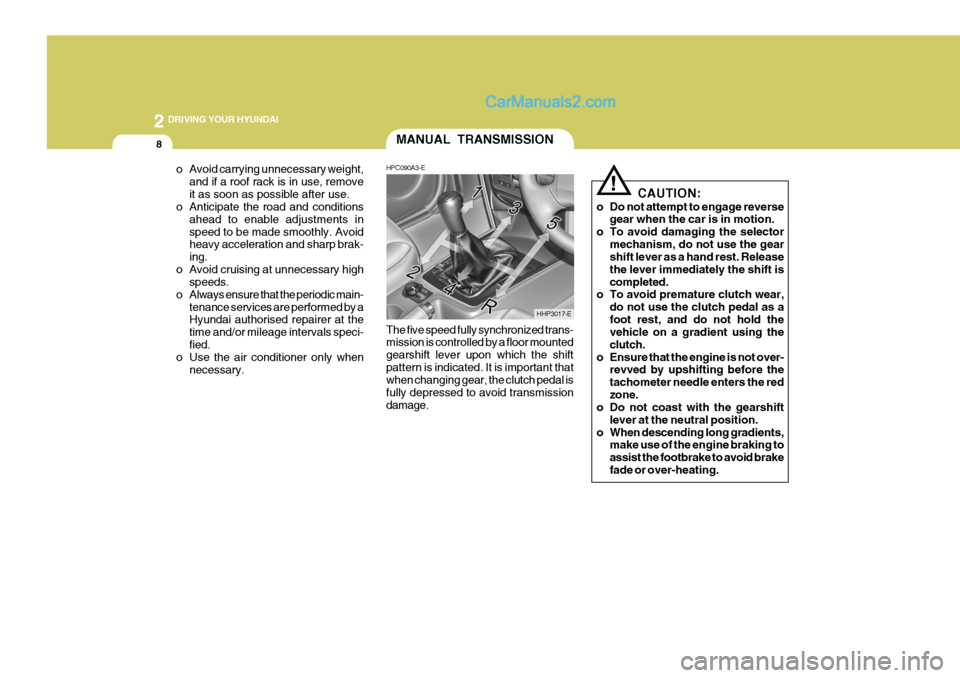
2 DRIVING YOUR HYUNDAI
8
!
o Avoid carrying unnecessary weight,
and if a roof rack is in use, remove it as soon as possible after use.
o Anticipate the road and conditions
ahead to enable adjustments inspeed to be made smoothly. Avoid heavy acceleration and sharp brak- ing.
o Avoid cruising at unnecessary high speeds.
o Always ensure that the periodic main- tenance services are performed by a Hyundai authorised repairer at the time and/or mileage intervals speci-fied.
o Use the air conditioner only when
necessary. The five speed fully synchronized trans- mission is controlled by a floor mounted gearshift lever upon which the shiftpattern is indicated. It is important that when changing gear, the clutch pedal is fully depressed to avoid transmissiondamage. CAUTION:
o Do not attempt to engage reverse gear when the car is in motion.
o To avoid damaging the selector mechanism, do not use the gear shift lever as a hand rest. Release the lever immediately the shift iscompleted.
o To avoid premature clutch wear,
do not use the clutch pedal as afoot rest, and do not hold the vehicle on a gradient using the clutch.
o Ensure that the engine is not over- revved by upshifting before thetachometer needle enters the redzone.
o Do not coast with the gearshift
lever at the neutral position.
o When descending long gradients, make use of the engine braking toassist the footbrake to avoid brakefade or over-heating.
MANUAL TRANSMISSION
HHP3017-E
HPC090A3-E
Page 425 of 539
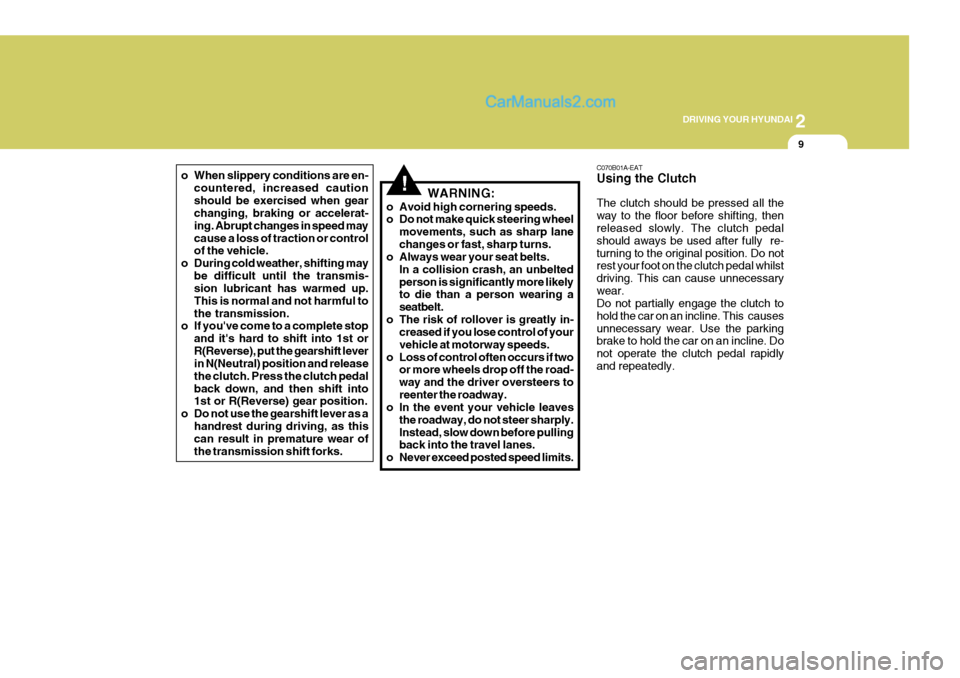
2
DRIVING YOUR HYUNDAI
9
o When slippery conditions are en-
countered, increased caution should be exercised when gear changing, braking or accelerat- ing. Abrupt changes in speed maycause a loss of traction or control of the vehicle.
o During cold weather, shifting may be difficult until the transmis-sion lubricant has warmed up. This is normal and not harmful tothe transmission.
o If you've come to a complete stop
and it's hard to shift into 1st orR(Reverse), put the gearshift lever in N(Neutral) position and release the clutch. Press the clutch pedalback down, and then shift into 1st or R(Reverse) gear position.
o Do not use the gearshift lever as a handrest during driving, as thiscan result in premature wear of the transmission shift forks. C070B01A-EAT Using the Clutch The clutch should be pressed all the way to the floor before shifting, then released slowly. The clutch pedal should aways be used after fully re-turning to the original position. Do not rest your foot on the clutch pedal whilst driving. This can cause unnecessarywear. Do not partially engage the clutch to hold the car on an incline. This causesunnecessary wear. Use the parking brake to hold the car on an incline. Do not operate the clutch pedal rapidlyand repeatedly.
!WARNING:
o Avoid high cornering speeds.
o Do not make quick steering wheel movements, such as sharp lane changes or fast, sharp turns.
o Always wear your seat belts.
In a collision crash, an unbeltedperson is significantly more likely to die than a person wearing a seatbelt.
o The risk of rollover is greatly in- creased if you lose control of yourvehicle at motorway speeds.
o Loss of control often occurs if two or more wheels drop off the road-way and the driver oversteers toreenter the roadway.
o In the event your vehicle leaves
the roadway, do not steer sharply.Instead, slow down before pulling back into the travel lanes.
o Never exceed posted speed limits.
Page 426 of 539
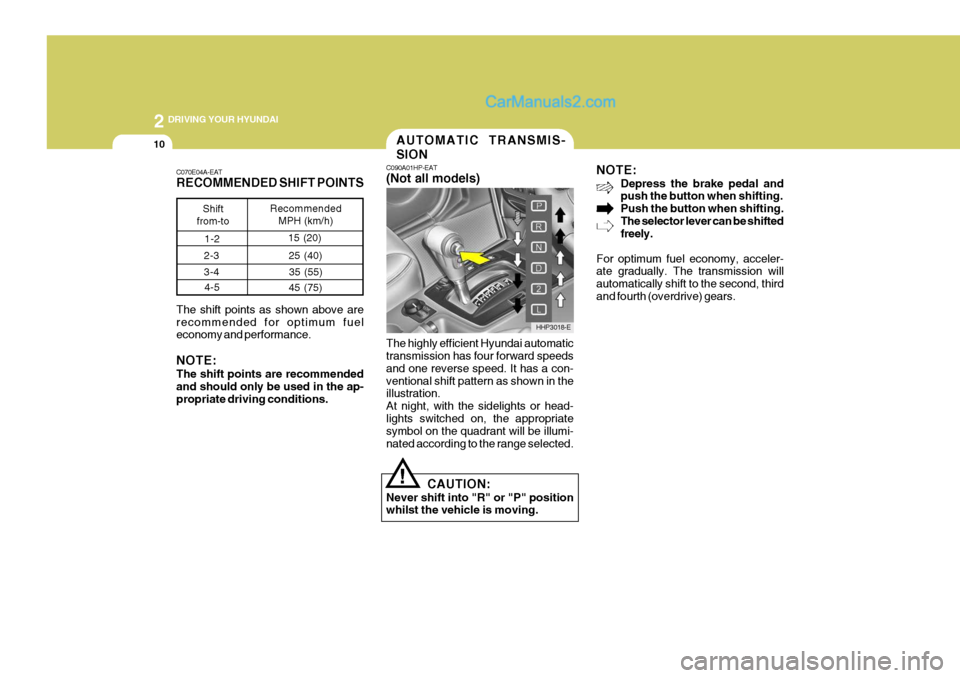
2 DRIVING YOUR HYUNDAI
10
!
The highly efficient Hyundai automatic transmission has four forward speeds and one reverse speed. It has a con-ventional shift pattern as shown in the illustration. At night, with the sidelights or head-lights switched on, the appropriate symbol on the quadrant will be illumi- nated according to the range selected. NOTE:
Depress the brake pedal and push the button when shifting. Push the button when shifting.The selector lever can be shifted freely.
For optimum fuel economy, acceler-ate gradually. The transmission will automatically shift to the second, thirdand fourth (overdrive) gears.
CAUTION:
Never shift into "R" or "P" position whilst the vehicle is moving.
C070E04A-EAT RECOMMENDED SHIFT POINTS The shift points as shown above are recommended for optimum fuel economy and performance. NOTE: The shift points are recommended and should only be used in the ap- propriate driving conditions.
Shift
from-to Recommended
MPH (km/h)
AUTOMATIC TRANSMIS- SION
C090A01HP-EAT (Not all models)
HHP3018-E
1-2
15 (20)
2-3 3-4 4-5 25 (40)
35 (55)
45 (75)
Page 427 of 539
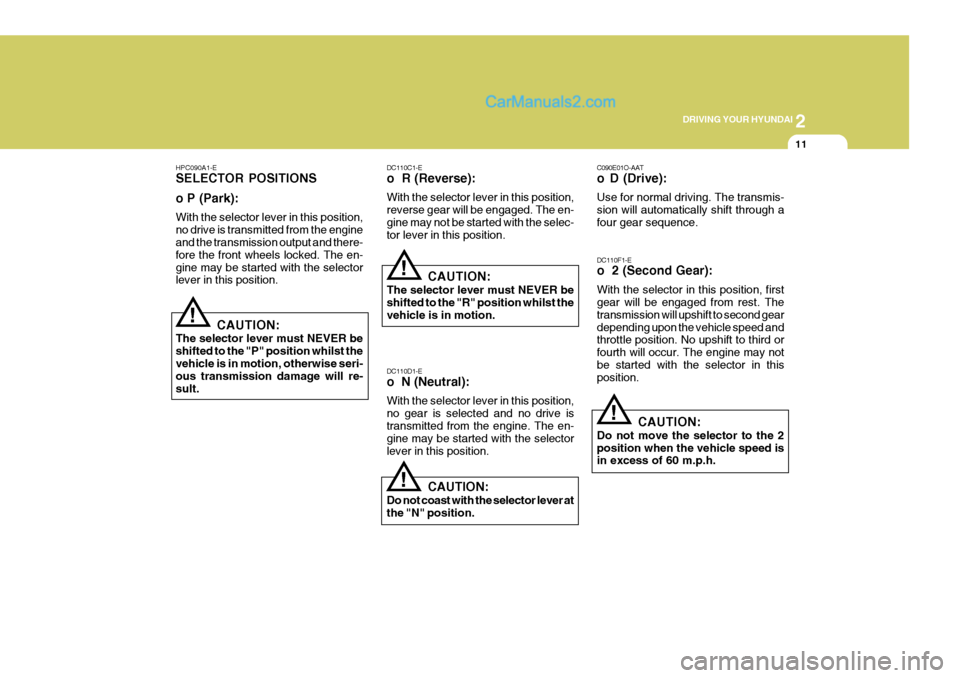
2
DRIVING YOUR HYUNDAI
11
!
HPC090A1-E SELECTOR POSITIONS o P (Park): With the selector lever in this position, no drive is transmitted from the engine and the transmission output and there- fore the front wheels locked. The en-gine may be started with the selector lever in this position.
CAUTION:
The selector lever must NEVER be shifted to the "P" position whilst thevehicle is in motion, otherwise seri- ous transmission damage will re- sult.
!
!
!
DC110C1-E o R (Reverse): With the selector lever in this position, reverse gear will be engaged. The en-gine may not be started with the selec- tor lever in this position.
CAUTION:
The selector lever must NEVER beshifted to the "R" position whilst the vehicle is in motion. DC110D1-E o N (Neutral): With the selector lever in this position, no gear is selected and no drive is transmitted from the engine. The en- gine may be started with the selectorlever in this position.
CAUTION:
Do not coast with the selector lever at the "N" position. C090E01O-AAT
o D (Drive): Use for normal driving. The transmis- sion will automatically shift through afour gear sequence. DC110F1-E o 2 (Second Gear): With the selector in this position, first gear will be engaged from rest. The transmission will upshift to second geardepending upon the vehicle speed and throttle position. No upshift to third or fourth will occur. The engine may notbe started with the selector in this position.
CAUTION:
Do not move the selector to the 2 position when the vehicle speed is in excess of 60 m.p.h.
Page 428 of 539
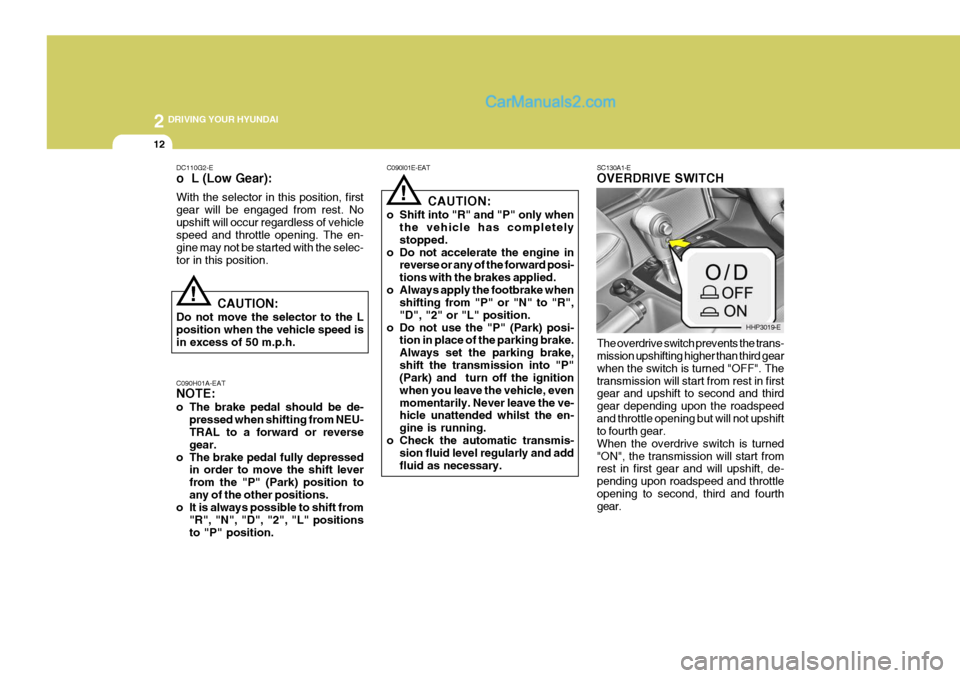
2 DRIVING YOUR HYUNDAI
12
!
C090I01E-EAT
CAUTION:
o Shift into "R" and "P" only when the vehicle has completely stopped.
o Do not accelerate the engine in reverse or any of the forward posi-tions with the brakes applied.
o Always apply the footbrake when shifting from "P" or "N" to "R","D", "2" or "L" position.
o Do not use the "P" (Park) posi- tion in place of the parking brake.Always set the parking brake,shift the transmission into "P" (Park) and turn off the ignition when you leave the vehicle, evenmomentarily. Never leave the ve- hicle unattended whilst the en- gine is running.
o Check the automatic transmis- sion fluid level regularly and addfluid as necessary. SC130A1-E OVERDRIVE SWITCH The overdrive switch prevents the trans- mission upshifting higher than third gear when the switch is turned "OFF". Thetransmission will start from rest in first gear and upshift to second and third gear depending upon the roadspeedand throttle opening but will not upshift to fourth gear. When the overdrive switch is turned"ON", the transmission will start from rest in first gear and will upshift, de- pending upon roadspeed and throttleopening to second, third and fourth gear.
!
DC110G2-E o L (Low Gear): With the selector in this position, first gear will be engaged from rest. Noupshift will occur regardless of vehicle speed and throttle opening. The en- gine may not be started with the selec-tor in this position.
CAUTION:
Do not move the selector to the Lposition when the vehicle speed isin excess of 50 m.p.h. C090H01A-EAT NOTE:
o The brake pedal should be de- pressed when shifting from NEU- TRAL to a forward or reverse gear.
o The brake pedal fully depressed in order to move the shift leverfrom the "P" (Park) position toany of the other positions.
o It is always possible to shift from
"R", "N", "D", "2", "L" positionsto "P" position.
HHP3019-E
Page 429 of 539

2
DRIVING YOUR HYUNDAI
13
Therefore, when the overdrive switch is turned "OFF", the transmission per-forms as a three speed unit and the overdrive warning light located in the instrument cluster will be illuminated.When the overdrive switch is turned "ON", the transmission functions as a fully automatic four speed unit with themaximum fuel economy potential of the vehicle being realized. HPC120D2-E General Operating Instructions
o The button in the selector handle
must be depressed before the selec- tor lever can be moved.
o The engine may only be started
when the selector is at position "P"or "N".
o Ensure that the footbrake is firmly
applied when shifting from "P" or"N" to "D", "2" or "L" and vice versa.
o Always engage the parking brake
when the vehicle is unattended,never use the "P" position in place of the parking brake.
o Under normal circumstances, the selector lever should be placed in the"D" position and the transmission allowed to select the most ideal ratiofor the circumstances. In this posi- tion maximum fuel economy will be achieved.
o When descending steep gradients where engine braking is required,the selector lever should be placedat the "2" or "L" position depending upon the vehicle speed. o When climbing steep gradients us-
ing large throttle openings, the trans- mission may repeatedly change be- tween two adjacent ratios. This is a normal characteristic and may beprevented by cancelling the over- drive facility if the shifting occurs between third and fourth ratios, se-lecting position "2" if the shifting occurs between third and second ratios or selecting position "1" if theshifting occurs between first and second ratios.
o Never move the selector lever to or from the "P" or "N" position with theaccelerator depressed.
o Ensure that the overdrive switch is at the "ON" position for maximumeconomy.
o If rapid acceleration is required, fully depress the accelerator pedal. Inthis condition, the kickdown mecha- nism will be operated and the trans-mission will automatically downshift according to the vehicle speed.
o The automatic transaxle may be used to great effect if the vehicle becomesstuck in snow or mud by allowing the vehicle to be rocked to and fro.
Page 430 of 539
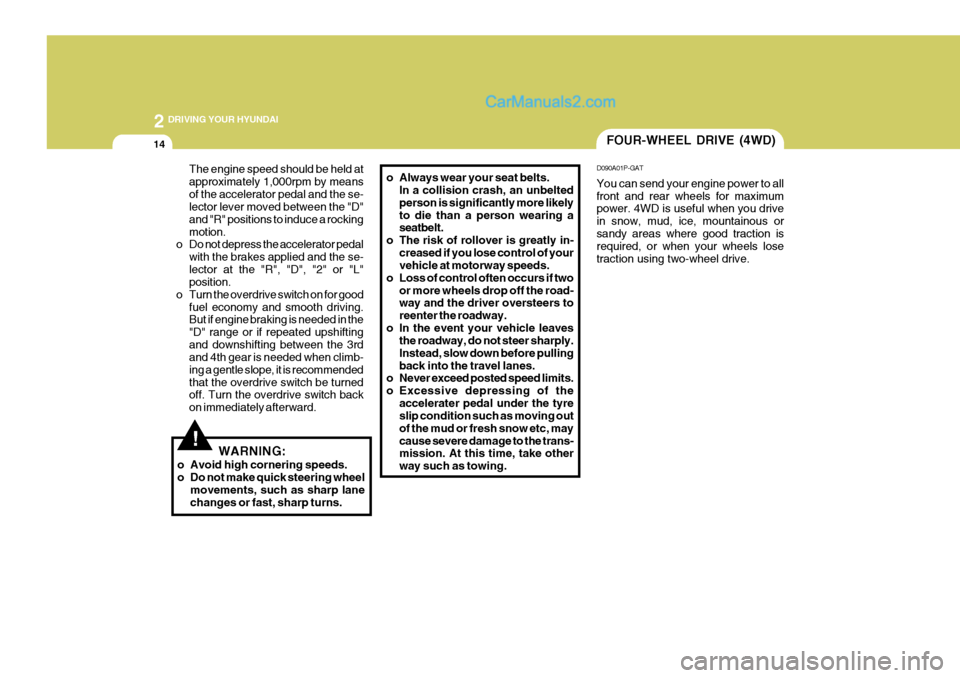
2 DRIVING YOUR HYUNDAI
14FOUR-WHEEL DRIVE (4WD)
D090A01P-GAT You can send your engine power to all front and rear wheels for maximum power. 4WD is useful when you drive in snow, mud, ice, mountainous orsandy areas where good traction is required, or when your wheels lose traction using two-wheel drive.
The engine speed should be held atapproximately 1,000rpm by meansof the accelerator pedal and the se- lector lever moved between the "D" and "R" positions to induce a rockingmotion.
o Do not depress the accelerator pedal
with the brakes applied and the se-lector at the "R", "D", "2" or "L" position.
o Turn the overdrive switch on for good fuel economy and smooth driving.But if engine braking is needed in the "D" range or if repeated upshiftingand downshifting between the 3rd and 4th gear is needed when climb- ing a gentle slope, it is recommendedthat the overdrive switch be turned off. Turn the overdrive switch back on immediately afterward.
!WARNING:
o Avoid high cornering speeds.
o Do not make quick steering wheel movements, such as sharp lanechanges or fast, sharp turns. o Always wear your seat belts.
In a collision crash, an unbeltedperson is significantly more likelyto die than a person wearing a seatbelt.
o The risk of rollover is greatly in- creased if you lose control of yourvehicle at motorway speeds.
o Loss of control often occurs if two
or more wheels drop off the road-way and the driver oversteers to reenter the roadway.
o In the event your vehicle leaves the roadway, do not steer sharply.Instead, slow down before pullingback into the travel lanes.
o Never exceed posted speed limits.
o Excessive depressing of the
accelerater pedal under the tyre slip condition such as moving out of the mud or fresh snow etc, maycause severe damage to the trans- mission. At this time, take other way such as towing.